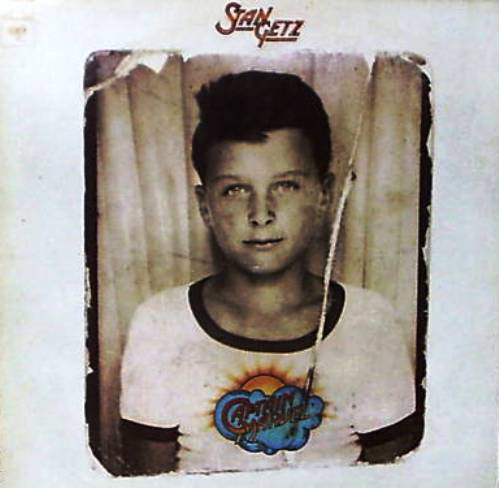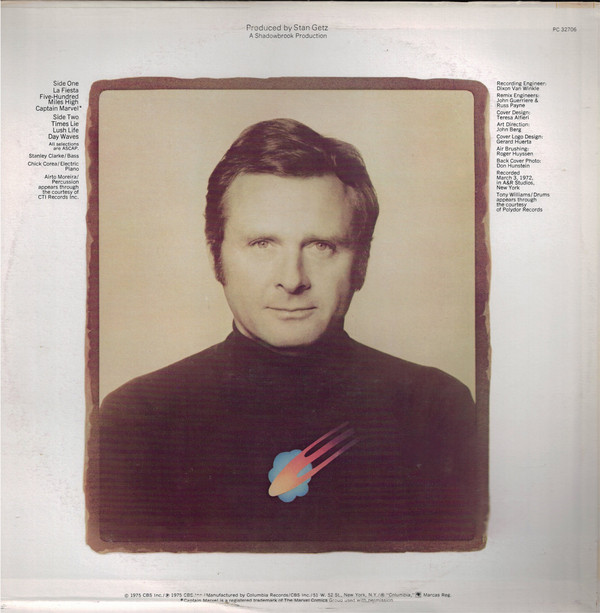
By the time Stan Getz recorded the album Captain Marvel with Chick Corea, Stanley Clarke, Tony Williams, and Airto Moreira, he had been in the music business for nearly thirty years. Getz began his career during the big band era, and cut his teeth with bandleaders as diverse as Stan Kenton, Benny Goodman, and Woody Herman. A leader of swinging small groups throughout the ‘50s, Getz spent some time in Europe following a career disruption caused by long-standing drug problems.
He returned to the U.S. in time to help sustain the Brazilian jazz-bossa craze, recording a series of albums with Joao Gilberto and wife Astrud Gilberto that remain among the most popular jazz recordings of all time. Getz continued to work and record at home and abroad throughout the 1960s, but by the end of the decade and the start of the next, things were changing rapidly. Traditional post-bop jazz was on the ropes, and there were a lot of new sounds in the air, many of them thanks to Miles Davis and his amazingly talented coterie of young sidemen. Getz was interested in putting together a new book of tunes for his return to New York following a European stay.
Chick Corea, a young pianist who had cut his teeth with Miles Davis’s first electric bands, recorded a couple of amazing trio dates under his own name, then moved on to form the avant-garde improvisational group Circle, was in the process of writing for and forming a new band that would be known as Return to Forever. The group would expand on Davis’s moves toward electric music and musical forms that communicated more directly with the listener than the abstract jazz of the late 1960s.
Corea and Getz crossed paths, and the idea of forming a quintet with Getz took hold. Corea brought along percussionist Airto Moreira and 20 year-old bass phenom Stanley Clarke. Rehearsals began, but according to the original liner notes by Albert Goldman, the project wasn’t quite jelling until Getz brought in drummer Tony Williams. Corea’s reminiscences in the new liner notes suggest that he brought the entire group to Getz, which makes sense since Corea and Williams had known each other for some time, even before they played together with Miles.
In any event, the band worked out the arrangements and opened at New York City’s Rainbow Room to wild acclaim and lines of potential listeners outside. Following the engagement that group went into the studio and recorded Captain Marvel, long acknowledged as one of the best jazz recordings of the ‘70s and a return to form for Getz. Sony Legacy reissued the album, remastered and with three additional tracks that only add to its legendary status.
Chick Corea composed five of the six tracks on the original album, and that fact says much about both Corea as a composer and Getz as a mature artist who knew talent when he heard it. There are many other artists who would not have felt comfortable recording the compositions of another, younger musician and allowing their young band so much room on something of a “comeback” album, but Getz was never an artist subsumed by ego, preferring instead to do whatever was necessary to provide the best musical experience possible. It also didn’t hurt that the pieces themselves had a heavy Latin flavor, which lent itself well to Getz’ propensity for rhythmic improvisation, nor that Corea’s soaring melodic lines allowed Stan the opportunity to utilize his beautiful, romantic tenor tone in their service.
“La Fiesta” became a mainstay, not only of Return to Forever’s book, but to the books of virtually every big band out there. Maynard Ferguson and Woody Herman had arrangements, as did virtually every small working jazz ensemble gigging at the time. Alternating between a paso doble and a bright, major-key melody that is as catchy as a top-40 pop song, it’s an irresistible piece that instantly creates goodwill between musicians and audience. Clarke roams at will across the lower range of the group’s sound while Williams drives the piece with an almost unbelievable energy, fusing the vigor of flamenco and the unexpected accents of bebop with the exciting drama of rock.

Corea’s Fender Rhodes work is transcendent on the entire album. To Corea the instrument’s very sound connoted magic, and the fullness and beauty of the tones he wrings from it could not have been done with an acoustic piano. He’s the perfect foil for Getz, both supporting him and driving him forward without ever becoming intrusive.
The first bonus track, a performance of the Corea ballad “Crystal Silence” shows how this new electric instrument could profoundly expand the language available to jazz keyboard players. The alternate versions of “Captain Marvel” and “Five Hundred Miles High” show that this band was creating at a high level.
In short, the fact that Getz was recording with a group of musicians who were leading jazz into the direction of fusion did nothing to alter his distinctive style. Though he was updating his sound and using the music of the day as a springboard, he was in no way attempting to merely do something that seemed fashionable at the time. Captain Marvel is a Stan Getz album because Getz is the nominal “leader” and the only horn player here, but ultimately this was a collaborative album by a group of musicians who were highly attuned to each other, and that is why the album has endured, and still sounds fresh today, over forty years since it was recorded.